
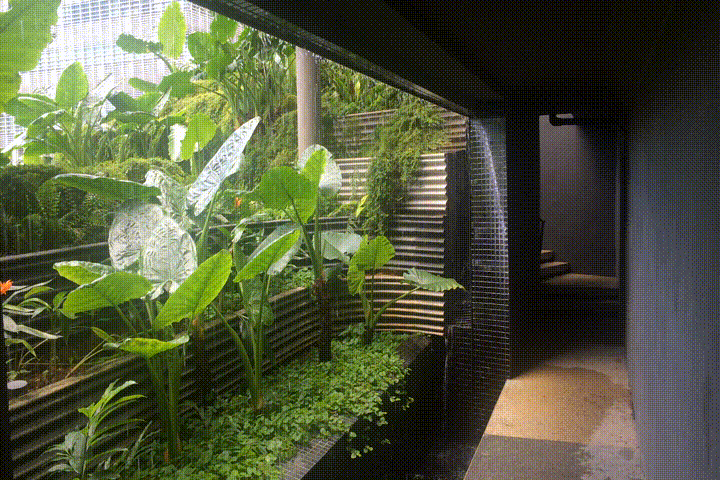
Features
Water for Wellbeing: Perspectives on Design Challenges
Catie Ryan
Share
Learn more about our biophilic design work and services by emailing us at [email protected] and reading our reports, 14 Patterns of Biophilic Design and The Economics of Biophilia. Follow the conversation on twitter: @TerrapinBG | #14Patterns.
* This feature is an adaptation of a post from Catie’s on-going series for Human Spaces, powered by Interface, outlining each of the 14 patterns of biophilic design. For a more in-depth look at this pattern and others, see the publication “14 Patterns of Biophilic Design“.
Water. From crashing waves to trickling streams, wading pools, and water fountains, water enhances the experience of a place. The Presence of Water biophilic design pattern has evolved from research on the health and wellbeing benefits associated with access to water, including reduced stress, lower heart rate and blood pressure, increased feelings of tranquility, positive emotional responsiveness, improved concentration and perception, and memory restoration. The general take-away from the research is that a frequent multisensory experience of clean water is very good for our psycho-physiological wellbeing.
More so than many other patterns of biophilic design, designers and owners are often wary of introducing Presence of Water into their projects. Some of the most common concerns are cost, sanitation, water scarcity, or cultural appropriateness of water features. However, there are many ways to incorporate Presence of Water into a design that overcome these challenges and provide multiple benefits.
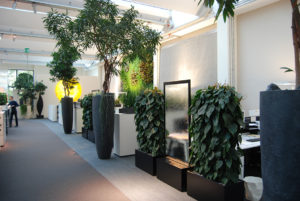
Modular water wall. Office of ArtAqua, Bietigheim-Bissingen, Germany. The modular water wall units serve as cubicle partitions in the open plan ArtAqua office. Each unit provides some visual and sound privacy, while also contributing to a focused yet restorative work environment. Photo copyright Bill Browning.
Cost & Scale of Water Features
Cost is among the most common deterrent to incorporating water features. Large or extensive water features can have a high first cost with continuous maintenance requirements built into the design. While thoughtful design should be able to mitigate concerns for energy intensity, risk of leakage, or humidity balance, large awe-inspiring water features are not always the most appropriate solution for optimizing health impact at a project site. For instance—when not value-engineered out—large water features are often situated in spaces where people don’t spend a lot of time (e.g., lobbies and other low density spaces), and as a result they tend to be a missed opportunity for engendering cognitive restoration and other benefits to our wellbeing.
When larger features are deemed appropriate and financially feasible, they should be placed in locations where the maximum number of people can experience them for a prolonged period of time, perhaps in locations with adequate seating. Smaller water features are often a good alternative, since they require less energy and maintenance, are generally self-contained, and can be designed to be mobile, allowing flexibility in space planning. Strategically situated, small fountains or water walls can serve multiple purposes, such as providing visual and speech privacy, increasing concentration, and supporting relaxation.
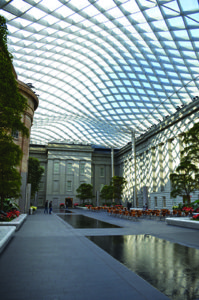
Water scrims and reflections. Kogod Courtyard, National Portrait Gallery, Smithsonian Institution, Washington, D.C. The thin sheets of water reflect light and clouds through the undulating canopy above. When the courtyard doubles as an event space, the system is drained to seamlessly become part of the floor plane. Photo copyright Tim Evanson.
Water Sanitation
Sanitation is a frequent concern with the presence of active water features, particularly for healthcare and food processing facilities. In spaces where such features cannot be introduced, projections and representations of water can provide some semblance of the presence of water and associated health benefits, while both minimizing first costs and maintenance and meeting health and sanitation requirements.
An operational water feature in an adjacent reception area or outdoor courtyard may serve as source or inspiration for indoor representations; for instance, light reflections from a water feature can be projected onto a ceiling or wall, and the sounds of a water feature can be broadcasted deep into a space or building. Sound and light originating from a small or distant water feature can alter the perception of its size and proximity. Awareness and novelty of the experience can be elevated by limiting auditory access to the most impactful locations within a space (i.e., not uniformly distributed) for targeted outcomes, such as to engender concentration or speech privacy in designated zones, or to draw pedestrians through the space toward a destination.
Water Resource Sensitivity
Resource sensitivities, particularly in water-poor regions, tend to place limitations or restrictions on engineered water features. Securing community acceptance and meeting sustainability goals are justifiably prioritized, though the value proposition of a presence of water is not always fully articulated. Projections and imagery of water are often a viable solution for water-sensitive sites. However, the presence of an active water feature also presents an opportunity—through responsible design—to educate users on issues of water scarcity and water efficiency, while optimizing positive health impacts and fostering a connection to place.
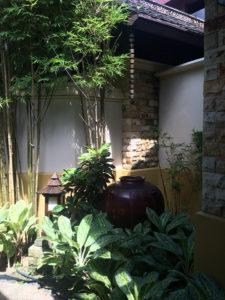
Rainchain. CHI, The Spa at Shangri-La Rasa Sayang Resort, Penang, Malaysia. The courtyard of this spa villa has a series of three rainchains paired with cisterns on a meandering gravel bed. Rainwater runs off the rooftop, down the rainchain and into the cistern to create a soothing sound or trickling water. Photo copyright Catie Ryan.
Small features can celebrate water as a precious resource. For instance, cyclical or closed-loop systems (e.g., modular or portable water fountains) that do not create a significant water burden, as well as naturally occurring or engineered ephemeral water features (e.g., rain chains, seasonal arroyos, rain gardens) can provide a restorative experience and help connect people to natural systems, while highlighting the seasonality or scarcity of water on the site.
Water Management Integration
Flood mitigation, surface drainage and quality control, and groundwater aquifer recharge are common site management concerns with water. Open-air rainwater management is an effective way of integrating the Presence of Water pattern for the benefit of both the landscape and the people who experience it.
Rainwater retention, harvest and reuse strategies provide prime opportunities for enhancing the human experience of a place. Historic management practices, decorative or spiritual applications, or passive cooling strategies can be designed to emphasize the functionality and climatic or cultural responsiveness of a space. At the site scale, a reflection pool or stepwell may double as a gathering place. An engineered wetland may enhance biodiversity and encourage groundwater recharge, while improving our access to nature for reflection or learning. At the building scale, the combination of an ornamental scupper with rainchain and French drain can serve as a practical drainage mechanism and, when clearly visible to the observer, can double as a seasonal Presence of Water intervention.
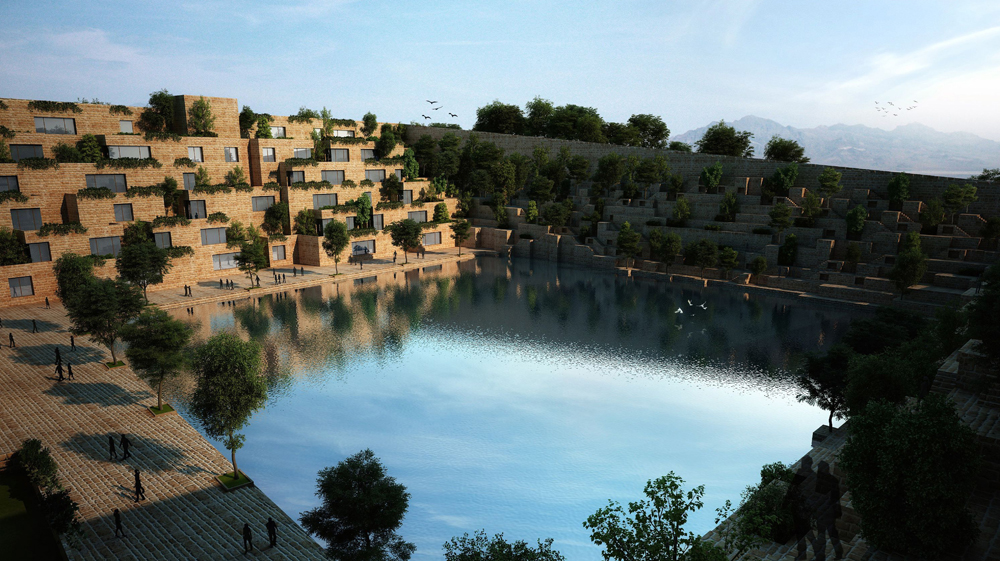
Reservoir. Rajasthan, India. The design of this office complex, by Sanjay Puri Architects, leverages the capacity of the steeply contoured site as a natural water collection pit from the surrounding land. Stepped wells located in Rajasthan since centuries were studied and the design of the built form is directly inspired by the form of the ancient stepped wells. Office spaces are on the two north facing sides gradually stepping down at each level along the existing contours generating north facing landscaped terraces fronting each office. The east and west sides provide stepped areas for users to stroll, sit in the shade, and watch the wildlife. Additionally, the original water collection area is to be enlarged to augment the water requirement of the entire township. Rendering courtesy of Sanjay Puri Architects.
Water features can be used to directly bridge the gap between human experience and building or site performance, such as when the feature becomes integral to outdoor rainwater management or indoor humidity control or acoustics. Systems integration for water resource management can also help justify the cost of water features, but necessitates early phase coordination with the MEP design team and facilities management, as well as possibly a landscape architect, environmental engineer, acoustician, or artist, depending on the strategy being pursued.
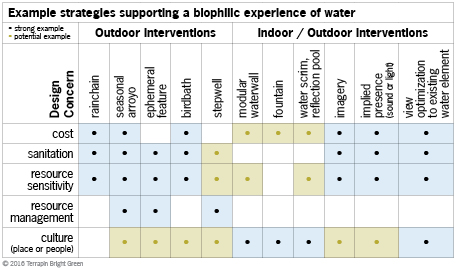
Example interventions and passive incorporation water features that address key design concerns while supporting a biophilic experience of water.
This is just a quick look at some of the possibilities for integrating a Presence of Water. There are many more! Water-based interventions can seem unnecessary or environmentally burdensome; however, in many cases, designers can still find interventions appropriate to their project, site, climate and cultural challenges. See the chart above for example water strategies that both support wellbeing and meet the needs of challenging or unique projects. Water-based interventions should be used to creatively overcome building design, environmental engineering and resiliency planning challenges while also providing significant health and wellbeing benefits.
Filed under:
Catie Ryan
Catie is the Director of Projects at Terrapin and a leader in biophilic design movement. With a background in urban green infrastructure, Catie's interest lies in systems thinking to address human health and sustainability challenges at each scale of the built environment.
Topics
- Environmental Values
- Speaking
- LEED
- Terrapin Team
- Phoebe
- Community Development
- Greenbuild
- Technology
- Biophilic Design Interactive
- Catie Ryan
- Spanish
- Hebrew
- French
- Portuguese
- Publications
- Occupant Comfort
- Materials Science
- Conference
- Psychoacoustics
- Education
- Workshop
- Mass Timber
- Transit
- Carbon Strategy
- connection with natural materials
- interior design
- inspirational hero
- biophilia
- economics of biophilia
- Sustainability
- wood
- case studies
- Systems Integration
- Biophilic Design
- Commercial
- Net Zero
- Resorts & Hospitality
- Energy Utilization
- Water Management
- Corporations and Institutions
- Institutional
- Ecosystem Science
- Green Guidelines
- Profitability
- Climate Resiliency
- Health & Wellbeing
- Indoor Environmental Quality
- Building Performance
- Bioinspired Innovation
- Biodiversity
- Residential
- Master Planning
- Architects and Designers
- Developers and Building Owners
- Governments and NGOs
- Urban Design
- Product Development
- Original Research
- Manufacturing
- Industrial Ecology
- Resource Management
- Sustainability Plans
- Health Care
- Carbon Neutrality


